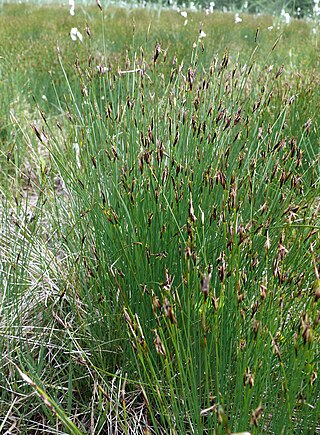
The Cyperaceae are a family of graminoid (grass-like), monocotyledonous flowering plants known as sedges. The family is large, with some 5,500 known species described in about 90 genera, the largest being the "true sedges" genus Carex with over 2,000 species.

Uncinia is a genus of flowering plants in the family Cyperaceae, known as hook-sedges in Australia and as hook grasses or bastard grasses in New Zealand. The genus is characterised by the presence of a long hook formed by an extension of the rachilla, which is used to attach the fruit to passing animals (epizoochory), especially birds, and it is this feature which gives the genus its name, from the Latin uncinus, meaning a hook or barb.
Mesomelaena is a genus of sedges. It has 5 known species, all endemic to Western Australia.

Schoenus is a predominately austral genus of sedges, commonly known as bogrushes, or veldrushes in South Africa. Species of this genus occur mainly in South Africa, Australia and Southeast Asia. Others are found in scattered locations worldwide, from Europe to Asia, North Africa and the Americas. Three species occur in the peatlands of southern South America, including S. antarcticus which is found in Tierra del Fuego, where it forms a component of hyperhumid Magellanic moorland.
Bulbostylis burbidgeae is a flowering plant in the sedge family, Cyperaceae, that is native to Western Australia.
Cyperus astartodes is a sedge of the family Cyperaceae that is native to northern parts of Australia.
Cyperus blakeanus is a sedge of the family Cyperaceae that is native to Australia.
Cyperus crispulus is a sedge of the family Cyperaceae that is native to Australia and found in Western Australia, and the Northern Territory.
Cyperus hesperius is a sedge of the family Cyperaceae that is native to Australia.
Cyperus latzii is a sedge of the family Cyperaceae that is native to Australia, and found in the Northern Territory and Western Australia.
Cyperus orgadophilus is a sedge of the family Cyperaceae that is native to Australia, in Western Australia, the Northern Territory, and Queensland.
Cyperus portae-tartari is a sedge of the family Cyperaceae that is native to Australia, and found in the Northern Territory and Western Australia.
Cyperus viscidulus is a sedge of the family Cyperaceae that is native to north western Australia.
Cyperus vorsteri is a sedge of the family Cyperaceae native to southern Africa.
Eleocharis jacobsiana is a sedge of the family Cyperaceae that is native to Western Australia.
Eleocharis rivalis is a sedge of the family Cyperaceae that is native to the Kimberley region of Western Australia.
Eleocharis sanguinolenta is a sedge of the family Cyperaceae that is native to the Kimberley region of Western Australia.
Eleocharis triquetra is a sedge of the family Cyperaceae that is native to the Kimberley region of Western Australia.
Jeremy James Bruhl is an Australian botanist. He is an emeritus professor in the School of Environmental and Rural Science at the University of New England and director of the N.C.W. Beadle Herbarium which holds c.110,000 plant specimens.
Karen Louise Wilson is an Australian botanist.


